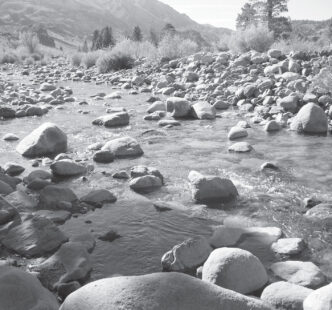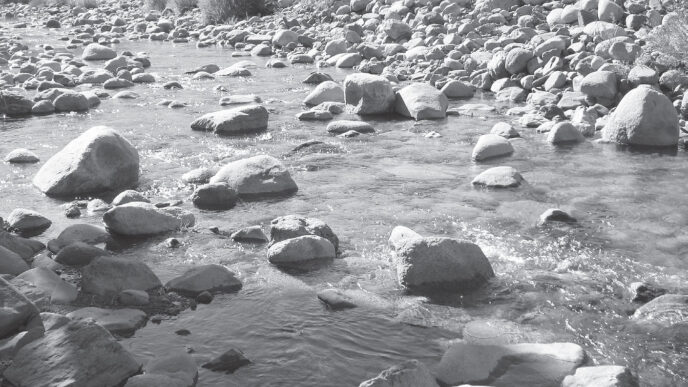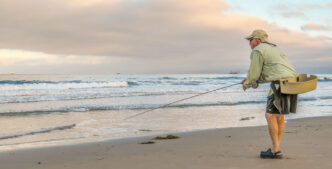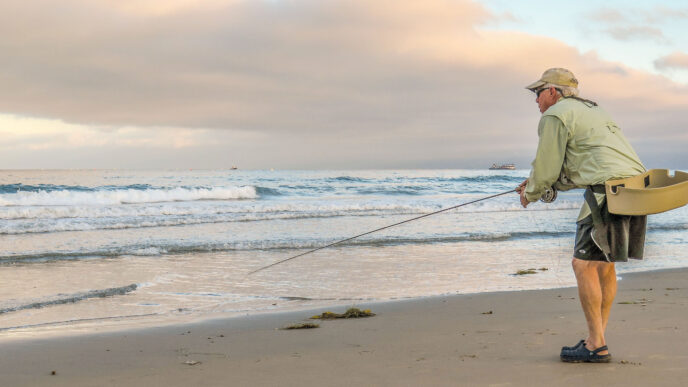Most who stand off the western edge of the continent in salt water up to their stripping baskets know that crabs are major forage in the California surf. The ubiquitous mole crabs (sand crabs) we see burrowing into the beach with each retreating wave — always a good sign for surf anglers — are a surfperch and corbina staple, and on Central and North Coast beaches mole crabs are important forage for striped bass, as well.
In addition to mole crabs, small or immature crabs of various species are often found in the surf zone and are readily taken by opportunistic predators. Halibut and corbinas love these free-crawling crabs, and when pelagic red crabs or a “hatch” of immature Dungeness crabs show up in the surf, everything eats them. I confess that I am a saltwater junkie. Fortunately, I live within walking distance of good Central Coast beaches, and these afford the opportunity to experiment with surf patterns. For a long time, trials with various mole crab designs of my own devise and others didn’t prove out to satisfaction — I found the best producers difficult and time-consuming to build and yielding only marginal results. Barred surfperch are jaded mole crab experts and will refuse one that does not look right. The teardrop-shaped mole crabs appear more like fanciful postmodern armored vehicles than like conventional crabs. All attempts to crack a producing mole crab pattern inevitably sent me back to fishing the suggestive, yet reliable Clouser or bonefish-style patterns so popular with California surf anglers.
Leaning on the bonefish/permit tradition, the development of fly patterns meant to simulate food forms of the California surf is still relatively in its infancy, with no great number of standard, recognized, indigenous producers archived to date. The Kung Fu Crab, a recent crossover from the bonefish flats that has produced some success fished for the selective corbina got me thinking, which led to a trip through the archives of bonefish patterns looking for inspiration. There, I happened across a couple of Eastern sand crab variations tied in the flat wing style, incorporating a cupped mallard flank feather to simulate a realistic shellback. The light bulb lit.
Happy circumstance, I had a bag of dyed-brown mallard flank feathers, a good color match for a mole crab going through the molt. It is while in the process of molting, newly emerged from the old shell, that crabs are most helpless and vulnerable. When the mole crab’s shell is fully hardened, it is blue-gray in color, but in the postmolt stage, it’s a brownish tan, and canny surf denizens, much preferring them, easily discern the prized soft shells from the hard ones.
Good perch runs on the local beaches led to encouraging results with the mallard-back versions, and continued trips to the beach led to refinements of the mole crab pattern down to a staple version — the one presented here, which I call simply the Mole Crab — and from the mole crab it was no great leap to a flat shelled crab, which I call the Red Crab.
Dyed mallard flank, sold loose by the bag, is inexpensive and useful in dressing Comets and Clousers meant for the surf, as well as for crabs. The bags contain a number of small cupped feathers suitable for achieving the distinctive teardrop shape of the mole crab. The flatter tips of larger feathers provide shellbacks for free-crawling crab imitations such as the Red Crab.
The flatwing crab patterns are fairly simple to tie, yet those without experience tying flatwings sometimes struggle with getting the shellback to lie properly. I proceed thus.
Prepare the feather by cutting the base away with scissors, leaving the finished length desired. Strip away only a few barbs from both sides of the stem at what is now the base of the feather. Position the feather directly on top of the hook shank, the stem base on center with the hook eye. With a thumb and forefinger, fold the feather barbs down over both sides of the hook shank and hold them there to lock the stem on center. Make a couple loose turns of thread over the feather at the tie-in point, slightly above the stripped portion, capturing the base of the first few feather barbs. Let the bobbin hang while checking the position — adjust as needed. Then wrap the tying thread toward the hook eye, loosely, until the thread comes off the stem, then back, tighter now, but not too snug where the feather exits the back of the head (the tie-in point). When layering feathers for a Mole Crab, place the smallest feather on the bottom, tied in toward the dumbbell eyes, the second tied in slightly ahead of the first, and the third and largest tied in on top, close to the hook eye. Though I use three feathers to maintain the round shape of the Mole Crab, only two are required for free-crawling crab imitations, and for these, the tips of larger feathers with the stiffest barbs work best. Mixing colors offers some interesting variants. Try a version with a pink flank feather on the bottom, with a slightly smaller olive or brown feather over it, leaving a pink fringe around the edge of the “shell.”

The Mole Crab
Hook: Mustad 34007-SS or similar, size 2. The fly is tied like a bonefish pattern, to ride hook-point up.
Thread: Tan
Weight: Silver or black lead dumbbell eyes, positioned on the side of the shank opposite the point about one-third shank length back from the hook eye. (I pretie dumbbells using 3/0 thread, doping each with a penetrating cement, then go over with a thick head cement or epoxy.)
Body: Pearl Cactus Chenille
Topping/shellback: Tied in between the dumbbell and the hook eye, in this order: a pinch of natural creamy raccoon underfur with guard hairs, extending slightly beyond the hook bend; two strands of pearl Midge Flash extending slightly beyond the hook bend; a section of pinkish-orange steelhead yarn, extending to the hook point — unfurl with a dubbing needle after tying in; three dyed-brown mallard flank feathers stacked flatwing style, extending to the hook bend. After completion, bend the shellback upward with a dubbing needle until it almost covers the hook point, then apply cement to the “head” and up onto the base of the shellback.

The Red Crab
Hook: Mustad 34007-SS or similar, size 2. The fly is tied like a bonefish pattern, to ride hook-point up.
Thread: Red, orange, or pink
Weight: Black dumbbell eyes
Legs: Red silicon “f loss” or yellow silicon floss dabbed with a red marker, two strands tied in as a tail and two strands tied on each side directly behind the dumbbell eyes. (Sure, one might add a couple more strands for a full count, but if there’s too much rubber, the legs tend to interfere with one another, inhibiting action, and I suspect the fish are unable to count legs that are moving. Also, I tie these without claws, because live, healthy crabs tend to scurry along the bottom with claws tucked tightly against the body, an exception to that being the diaphanous pelagic red crab, which drifts on the current, its long legs and tiny claws streaming out.)
Body: Pearl Cactus Chenille
Topping/shellback: Tied in between the dumbbell and the hook eye, in this order: a pinch of pink calf tail, extending to the hook bend; a small pinch of red bucktail fibers, extending slightly beyond the hook bend; two strands of copper Midge Flash, extending slightly beyond the hook bend; a pinch of red calf tail, extending to the hook bend; two red mallard flank feathers tied in flatwing style, extending to the hook bend. Finish the same way as the Mole Crab.
















